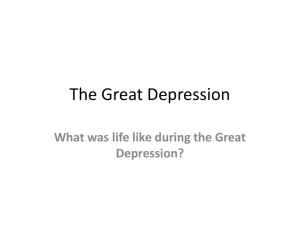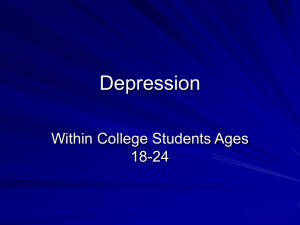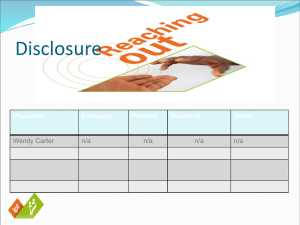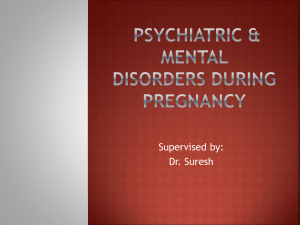Perinatal Depression - The University of Texas at Austin
advertisement
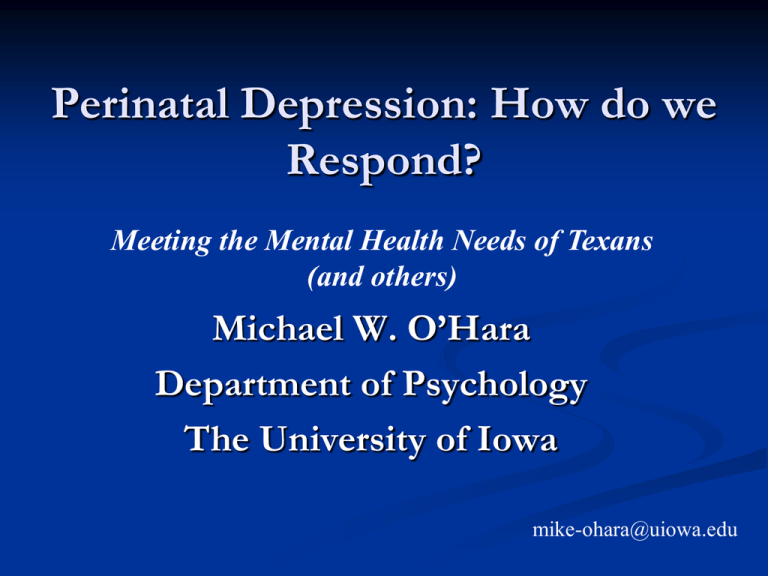
Perinatal Depression: How do we Respond? Meeting the Mental Health Needs of Texans (and others) Michael W. O’Hara Department of Psychology The University of Iowa mike-ohara@uiowa.edu Iowa Depression and Clinical Research Center Team in Iowa City Sarah Bell Jen Bowman-Reif, MS Melissa Buttner, MA Jane Engeldinger, MD Sheehan Fisher, PhD Rebecca Grekin Corinne Hamlin, MAT Robin Kopelman, MD Jennifer McCabe Michelle Miller Kimberly Nylen, PhD Michael O’Hara, PhD Jennifer Richards, MSW Heather Rickels, MA Lisa Segre, PhD Scott Stuart, MD J Austin Williamson, MA Outline of Presentation Burden of Depression What is Postpartum/Perinatal Depression Risk Factors Prevalence Screening Treatment: Impact on mother Treatment: Impact on infant Summary Burden of Depression in Women Second leading cause of disability (lost years of healthy life) among women in the world aged 15 to 44 years In the U.S. depression is the leading cause of non-obstetric hospitalizations among women aged 18-44 Sources: The World Health Report 2001, Geneva: WHO; Jiang et al. 2000 ‘Care of Women in U.S. Hospitals, 2000.’ Burden of Perinatal Depression For mother Personal suffering, continued depression, poor health For the child Delayed prenatal care, shorter gestation Fussiness, feeding problems, poor weight gain Delays: cognitive skills, social skills, language Behavioral problems, insecure attachment Later depression For the family – marital discord, divorce Perinatal Depression: Definition Major or minor depression that begins or continues in pregnancy and the postpartum period (usually up to one year after delivery) DSM-IV criteria – postpartum onset Does not include: Postpartum blues Postpartum psychosis Often co-morbid with anxiety disorders or significant anxiety symptoms Criteria for Diagnosing Depression Symptoms (at least one of first two and total of five) Depressed mood Loss of interest or pleasure Significant weight or appetite change Insomnia or hypersomnia Psychomotor agitation or retardation Fatigue or loss of energy Feelings of worthlessness or inappropriate guilt Impairment in thinking, concentration, or decisions Recurrent thoughts of death or suicide Causal/Risk Factors for PPD O’Hara et al. (1982 – 2007) Several prospective and cross-sectional studies Outcomes: Depression diagnosis and symptoms Predictors of PPD Past depression (level, diagnosis, past history) ++ Ψ vulnerability ± Life events (incl. childcare, obstetric) ++ Social support (incl. marital, non-marital) ++ Low income + (…but only in cross-sectional studies Hormones – Meta-Analytic Findings Past depression or anxiety disorder Life stress Unplanned/unwanted pregnancy, obstetrical Losses (e.g., housing, job, divorce/separation) Conflicts with family, co-workers, friends, children Natural disasters (e.g., fires, floods, tornadoes) Poor social support (from partner, family, friends) Socioeconomic disadvantage O’Hara & Swain, 1996; Beck, 2001; Robertson et al., 2004 Prevalence of Perinatal Depression Prospective studies (O’Hara et al., 1984; 1990) Pregnant/Postpartum women Non-pregnant/postpartum controls 8-9% pregnancy; 10-12% post partum 5.6% pregnancy; 7.8% post partum (NCB) Childbearing and non-childbearing rates were not different What the literature suggests O’Hara & Swain (1996) 54 studies; 12,910 subjects 13% prevalence rate for postpartum period Gavin et al. (2005) 28 studies (all based on diagnosis) 18.4% pregnancy period prevalence 19.2% postpartum period (first 3 months) No evidence of increased risk over other times Recent Large Scale Study Vesga-Lopez et al. (2008) National representative survey 13,025 non-pregnant; 994 post partum Adjusted odds ratio for postpartum women 1.52 (1.07-2.15) Depression .55 (.31-.96) Receiving treatment Women are at increased risk for depression in the postpartum period …but are less likely to be treated. Implications or What’s so special about perinatal depression? It is prevalent during pregnancy and the postpartum period Women suffer Negative consequences for women, their children, and families Often are not treated …but women have frequent contact with health care providers during and after pregnancy Role of the PCP in Detecting Depression Recommendations of U. S. Preventive Services Task Force (2009) Recommendations of ACOG Committee on Obstetric Practice (2010) Recommendation of the USPSTF “The U.S. Preventive Services Task Force recommends screening adults for depression when staff-assisted depression care supports are in place to assure accurate diagnosis, effective treatment, and follow-up (Grade B)” Source: U.S. Preventive Services Task Force. (2009). Screening for depression in adults: U.S. Preventive Services Task Force recommendation statement, Annals of Internal Medicine, 151, 784-792. ACOG – Committee on Obstetric Practice Recommendations “Depression is very common during pregnancy and the postpartum period. At this time there is insufficient evidence to support a firm recommendation for universal antepartum or postpartum screening. There are also insufficient data to recommend how often screening should be done. However, screening for depression has the potential to benefit a woman and her family and should be strongly considered. Women with a positive assessment require follow-up evaluation and treatment if indicated. Medical practices should have a referral process for identified cases. Women with current depression or a history of major depression warrant particularly close monitoring and evaluation.” Committee on Obstetric Practice. (2010). Screening for depression during and after pregnancy. Obstetrics and Gynecology, 115, 394-395 PPD Screening Screening is feasible (Gordon et al., 2006; Segre, Brock, O’Hara, Gorman & Engeldinger, 2010; Yonkers et al., 2009) Primary care providers can be trained quickly and effectively (Baker, Kamke, O’Hara, & Stuart, 2009) Both on-line and in-person trainings are available (Baker et al., 2009; Segre et al., 2010; Wisner et al., 2008) What needs to be in Place A tool for detection EPDS; PDSS; PHQ-9; Two question screen A decision rule for further assessment An approach to physician evaluation of possible depression Referral, treatment, follow-up protocols Following up on Positive Screens Follow-up with positive items on screen Understand the context More formally assess and possibly diagnose depression Rule out alternative medical explanations Ask about concerns or preferences for treatment Initiate treatment or referral Physician’s Role Medication management Refer for medication management Refer for counseling/psychotherapy Refer for social services Treatment Medication TCA; SSRI; SNRI; Mood Stabilizer Psychotherapy Interpersonal Psychotherapy (IPT) Cognitive-Behavioral Therapy (CBT) Listening Visits Group Therapy Treatment Complementary and Alternative Approaches Bright Light Therapy Exercise, Nutrition Herbals, Acupuncture, Yoga Peer Support and Education Postpartum Support International Evaluating IPT for Postpartum Depression (O’Hara et al., 2000) 120 postpartum depressed women DSM-IV major depression Recruited from the community 12 sessions IPT or 12 weeks of waiting Treatment provided by community clinicians Assessments included depression, social adjustment, infant behavior, and mother-infant interaction Also followed a cohort of nondepressed mothers and infants IPT for Postpartum Depression: Hamilton Rating Scale for Depression (HRSD) 25 20 15 IPT WLC 10 5 0 Pre-therapy 4-Wks 8-Wks 12-Wks IPT for Postpartum Depression: Major Depression at 12 week Assessment 70 60 50 % 40 69% 30 20 10 12 % 0 MDE at 12 Week Assessment IPT WLC Wait List Group after IPT (N=47) HRSD 18 16 14 12 10 WLC 8 6 4 2 0 Pre-therapy 4-Wks 8-Wks 12-Wks Relapse and Recovery Nylen, O’Hara et al. (2008) Relapse following IPT Recovery for treatment non-responders 12 months - 42%; 18 months - 48% 84% of women not recovered with treatment recovered over 18 months Proportion of month depressed during follow-up Month six post-treatment Month twelve post-treatment Month eighteen post-treatment 39% 35% 26% Evidence for Treatment Efficacy Empirical validation General population Medication and psychotherapy ….but, effects for mild to moderate depression may be no greater than placebo Postpartum women Numerous RCTs demonstrate efficacy of psychotherapy for postpartum depression Relatively few studies of antidepressant medication, mostly positive, but mostly uncontrolled Impact of treatment on offspring (Forman, O’Hara et al., 2007) Little impact on infant behavior Mothers reported less parenting stress 18 months later treated depressed mothers (compared to non-depressed mothers) rated their children as: lower in attachment security; higher in negative temperament & behavior problems …all of this suggests that parenting behaviors should be a target of therapy Parenting Interventions Lynne Murray & Peter Cooper (2003) CBT, psychodynamic, and non-directive counseling approaches to PPD and altering the M-I relationship “Indications of a positive benefit were limited.” Roseanne Clark (2003; 2008) Mother-Infant Therapy Group for PPD and M-I relationship Intensive 12 week treatment including mothers’ group, infants’ group, and mother-infant group. Relative to WLC, M-I group found infants more reinforcing, and more positive in interactions Conclusions and Next Steps for Parenting Interventions Little evidence that treatment for PPD improves parenting Modest evidence that focus on parenting in context of PPD treatment is efficacious Most parenting interventions with infants have been driven by infant rather than maternal problems New interventions, possibly introduced during pregnancy must be developed in increase sensitivity in at risk and depressed mothers in pregnancy and the postpartum period. Take Home Messages Perinatal Depression: Prevalent Significant mental health problem Consequences extend to offspring and family Detection in Ob-Gyn and primary care settings Professional treatments effective…but Coordination of care and uptake of services remain challenges Interventions that target the M-I relationship





